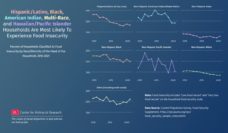Food insecurity is consistently linked with poor mental health. Feelings of extreme anxiety and guilt can take hold if you can’t afford enough food or must sacrifice basic needs to buy groceries. Food-insecure Americans are at a three-times greater risk for both anxiety and depression than those who do not have to worry about having enough to eat. They also have an increased risk for suicidality.
The Supplemental Nutrition Assistance Program (SNAP) is the largest U.S. program addressing food insecurity, assisting over 40 million people each year. SNAP requires households to meet several criteria to receive benefits. In general, households must pass an asset test, meaning that they can’t have more than $2,750 saved, and household income must be approximately $30,000 or less per year for a family of three.
To give more families access to SNAP benefits, states have the option to expand SNAP eligibility using two methods: 1) eliminate the asset test; 2) increase the income limit. Thirty-nine states have already dropped the asset test. And 37 states have increased the income ceiling with 20 states increasing to approximately $46,000 for a family of three.
Anna Austin and her team investigated possible links between different state SNAP eligibility criteria for food-insecure people and mental health and suicide rates. Using data from the National Survey on Drug Use and Health and the National Vital Statistics System, they compared mental health outcomes between states that have not expanded SNAP with those that either eliminated the asset test, or eliminated the asset test and increased the income limit.
For many households, increasing eligibility has the added benefit of stabilizing SNAP benefits.
They found that SNAP eligibility may help to decrease the burden of mental illness and suicidality for food insecure people. States that adopted both SNAP eligibility policies reported decreasing rates of major depressive episodes, diagnosable mental, behavioral, and emotional disorders, and suicidal ideation. States that only eliminated the asset test also saw decreases in major depressive episodes and mental illness, but not in suicidal ideation.
The researchers suggest that, by expanding the number of families who are eligible for SNAP, more vulnerable households are getting much-needed financial support to buy their groceries and meals, lessening the stress that comes with food insecurity. For many households, increasing eligibility has the added benefit of stabilizing SNAP benefits. For example, if your state increases the income limit, you can accept a new job with higher pay without the fear of losing your SNAP benefits.
While these findings are promising, they need to be interpreted with caution. The study measured state-wide mental health outcomes including all residents, regardless of whether or not they were eligible for SNAP. On the one hand, using state-wide data broadens our perspective on the impact of SNAP policies on mental health outcomes, acknowledging the positive spillover effects they can have beyond food-insecure people. However, the study may dilute the observed effects by not focusing exclusively on the food-insecure, making it harder to attribute changes solely to SNAP eligibility policies.
Increasing access to SNAP can bring stability to food insecure homes beyond improving mental health indices. Recent studies have shown that states that expanded SNAP eligibility saw reduced rates of Child Protective Services cases and reports, specifically those resulting from neglect.
Greater use of SNAP benefits can also have broad positive economic effects. SNAP payments can provide a boost to local businesses. According to the USDA, every $1 in SNAP benefits generates $1.50 in economic activity. The multiplier effect can help to create jobs and stimulate economic growth, especially in neighborhoods with high rates of poverty and food insecurity.
Photo via Getty Images














